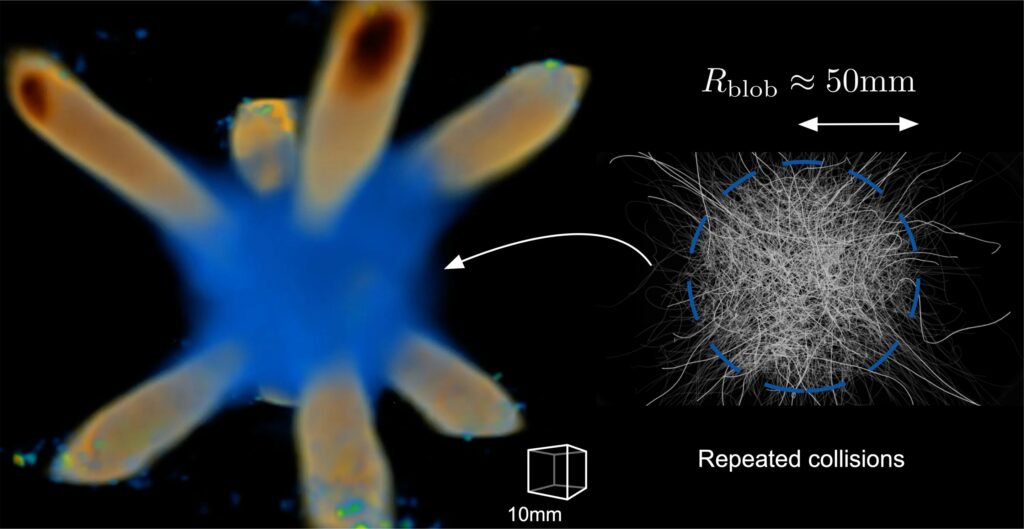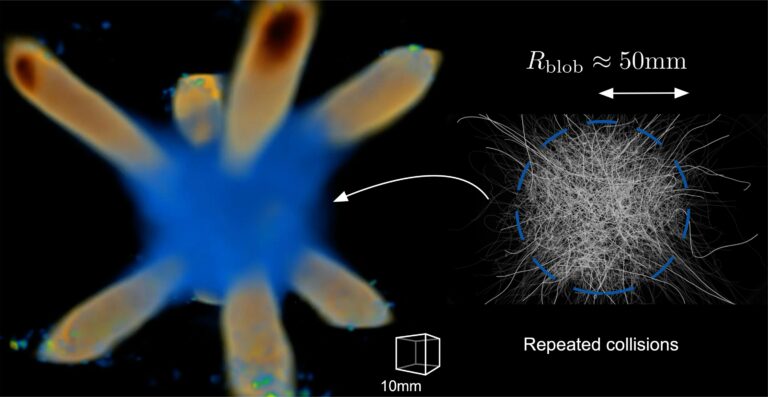Revolutionizing the Management of Turbulence Characteristics
The phenomenon of turbulence, characterized by chaotic alterations in flow velocity and pressure in fluids, has been extensively studied in physics. Despite being a common occurrence in nature, manipulating and controlling the properties of turbulence has presented considerable challenges. Researchers at the University of Chicago have recently introduced a novel approach to effectively control the location, position, and properties of turbulence in experimental settings. This innovative strategy, outlined in a paper published in Nature Physics, enabled the creation of an isolated turbulent entity within a tranquil environment.
“Turbulence is omnipresent, as evident in everyday scenarios like stirring coffee with a spoon,” explained Takumi Matsuzawa (first author) and William Irvine (corresponding author) to Phys.org. “However, manipulating this transient phase of matter is not as straightforward as with other conventional phases such as solids and liquids. Often, material boundaries, like the spoon in the example, obscure the origins of the turbulence. This led us to explore the possibility of creating an isolated turbulence blob and maintaining its position.” In their recent study, Irvine and colleagues aimed to establish a confined state of turbulence within a calm environment, necessitating precise control over turbulence properties.
The successful creation of such an isolated turbulent blob holds the potential for intriguing new avenues in research, providing physicists with opportunities to address questions that have proven challenging using traditional experimental methods. “Some of the questions that could be explored following our study include: What occurs at the interface of turbulent and non-turbulent flows? How are conserved quantities such as energy and impulse transported across the interface? Are there different types of turbulence depending on the combinations of conserved quantities?” Irvine and Matsuzawa elaborated.

Numerous physics textbooks and theoretical works commonly depict turbulence as a complex mixture of swirling motions referred to as “eddies.” While the precise nature of these eddies remains somewhat enigmatic, they essentially represent deviations in fluid movement from its overall flow, manifesting as circular currents or vortices. “Our proposed approach involves constructing turbulence by introducing eddies one at a time, akin to assembling Legos,” explained Irvine. “
The true nature of an eddy is not fully understood, but a viable candidate is the vortex ring, analogous to a smoke ring, as it embodies a robust fluid structure capable of traveling far from material boundaries. Additionally, its properties can be accurately measured, providing insight into what contributes to turbulence.” In their experiments, Matsuzawa orchestrated sets of eight vortex rings within a chamber by directing them towards the center of a cubic water-filled tank from its eight corners. If these vortex rings were released as a single set, they would disperse and redirect due to vortex reconnections.
However, by repeatedly releasing them, as the researchers did, it resulted in the formation of an isolated turbulence blob. “Our approach offers distinctive design principles for localizing, positioning, and controlling turbulence,” noted Irvine. “The properties of the blob are determined by those of the vortex rings; the size is dictated by the ring radius, and the inner turbulent intensity is governed by the energy carried by the rings. By combining helical loops, we could also introduce other conserved quantities such as angular impulse and helicity, whose roles in turbulence are not yet well-understood.” This recent work by the research team significantly advances the study of turbulence by introducing an effective experimental control strategy.
In the future, the approach outlined in their paper holds the potential to facilitate studies that were previously challenging. This could contribute to addressing longstanding research questions related to the underlying physical processes of turbulence. “We are currently exploring how turbulence naturally evolves in a tranquil environment,” Irvine added. “This is a crucial inquiry regarding how turbulent fluctuations propagate and dissipate. Additionally, we are interested in investigating how turbulence retains or ‘forgets’ its initial conditions. It is believed that turbulence remains universal at small scales, even with varied vortical structures in the input. Our system presents an ideal opportunity to examine the memory aspect of turbulence by adjusting the input through a combination of diverse vortex loops.”
This article is republished from PhysORG under a Creative Commons license. Read the original article.
Do not forget to share your opinion with us to provide you with the best posts !




0 Comments